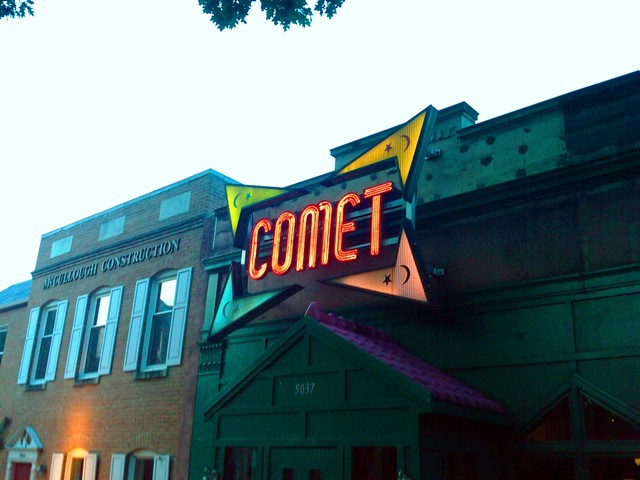
Fake news stories circulated about Comet Ping Pong, a restaurant in Washington, DC. Image source: Wikimedia Commons
Fake news stories show no sign of abating and are afflicting businesses as many had feared. PR pros may now need to add attacks in fake news to their PR crisis plans.
Fake news became increasingly common during the 2016 Presidential campaign as unscrupulous publishers learned they could make advertising money by making up stories. Gullible readers shared fake stories on social media, most notably Facebook, spreading the posts’ reach and boosting visits to the publishers’ websites.
Now that they’ve seen how it can be done, a range of characters — including anti-corporate activists, stock short sellers, disgruntled customers and even bottom-feeding PR pros — are posting fake news about companies and brands.
Spread of the Pizza-gate Fake News Story
The problem is mushrooming fast, and even small businesses are vulnerable. A pizza owner and his staff received death threats and other threatening messages on social media after a fake news reports said his Washington, D.C., restaurant was home base for a child abuse ring led by Hillary Clinton and John D. Podesta. Dozens of made-up articles said Clinton was kidnapping, molesting and trafficking children in the restaurant’s back rooms.
“From this insane, fabricated conspiracy theory, we’ve come under constant assault,” restaurant owner James Alefantis told the New York Times.
Harassment continued after he made that comment. A man was arrested Sunday after carrying a rifle into the restaurant and firing a shot. Fortunately, no one was injured, and he was charged with assault with a dangerous weapon. A Brooklyn pizzeria suffered similar harassment after being mentioned in fake news reports.
PepsiCo was probably the most recent example of a large company victimized by faked news. Supporters of president-elect Donald Trump advocated a boycott of Pepsi after a fictitious article that PepsiCo CEO Indra Nooyi told Trump fans to “take their business elsewhere.” Fake news sites published the fake quote and urged a boycott. They also incorrectly claimed the comment caused the company’s stock to drop 5 percent. Nooyi did criticize Trump’s comments about women and said her employees were worried about his election, but the CEO also congratulated him on his victory.
Facebook & Google Responses may be Futile
Facebook and Google have vowed to crack down on the problem. Google announced that it would ban fake news websites from using its online ad service, while Facebook promised to develop better ways for users to identify fake content. Media observers and fake news purveyors say the trend cannot be stopped.
“I know ways of getting hooked up under different names and sites. So probably if they cracked down, I would try different things. I have at least 10 sites right now. If they crack down on a couple, I’ll just use others. They could shut down advertising on all my sites, and I think I’d be okay,” one prolific fake news publisher told the Washington Post.
PR Crisis Preparation and Responses
Experts urge PR pros to take these steps.
- Add fake news to PR crisis preparedness plans.
- Meet with your team to discuss and prepare tactics to deploy. Brainstorm different scenarios and create responses to them.
- Think about which will escalate, who will be responsible for responses, and how they will communicate.
- Develop relationships with influencers who can help counter falsehoods. “Now is the time to build great and trustworthy relationships with high-profile journalists and influencers, and with your best brand ambassadors,” says Gini Dietrich, founder and CEO of Arment Dietrich, in her Spin Sucks blog. “These are the people who will help you when your competitor decides to take you down by creating fake news.”
- Closely monitor both social media and traditional media, especially websites known to produce false information.
- Subscribe to real-time alerts that will immediately inform you when your company, products or other keywords are mentioned online.
- When alerted by a media monitoring service, immediately issue press statements and social media posts to deny deceptions.
- Seek a takedown of the original story, although legal action may have little impact. “In most cases, while legal fights will ensue and you will eventually win, the court of public opinion will already have beat you,” Dietrich notes.
- Consider human analysts. Automated monitoring and measurement software may not be able to detect a fake news story. That may require human analysts who are knowledgeable about the organization and its products. The content analysis to identify fake news stories could be outsourced to the media monitoring service or done by the organization’s own staff.
Bottom Line: Organizations are rightly alarmed by the spread of fake news. Phony news reports continue to spread and now victimize even small businesses. PR pros must now add responding to fake news to their repertoire of skills. The key is constant vigilance and spotting the falsehoods before they spread extensively on social media.
William J. Comcowich founded and served as CEO of CyberAlert LLC, the predecessor of Glean.info. He is currently serving as Interim CEO and member of the Board of Directors. Glean.info provides customized media monitoring, measurement and analytics solutions across all types of traditional and social media.




